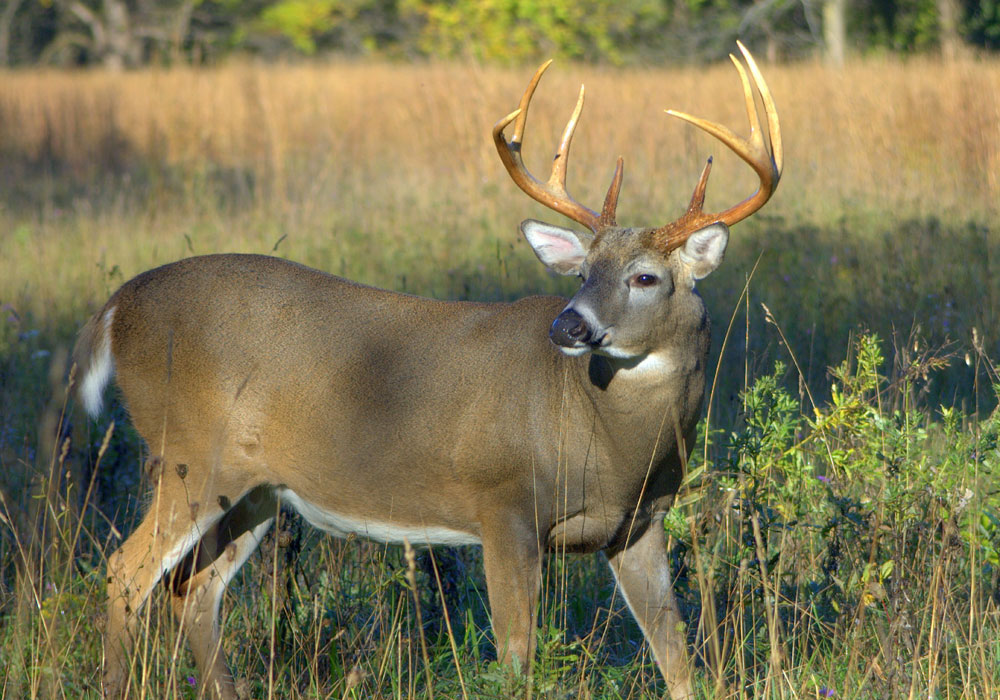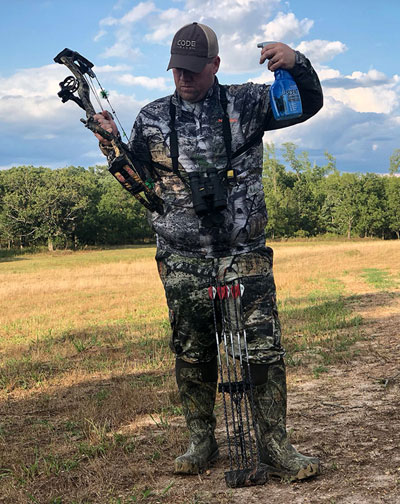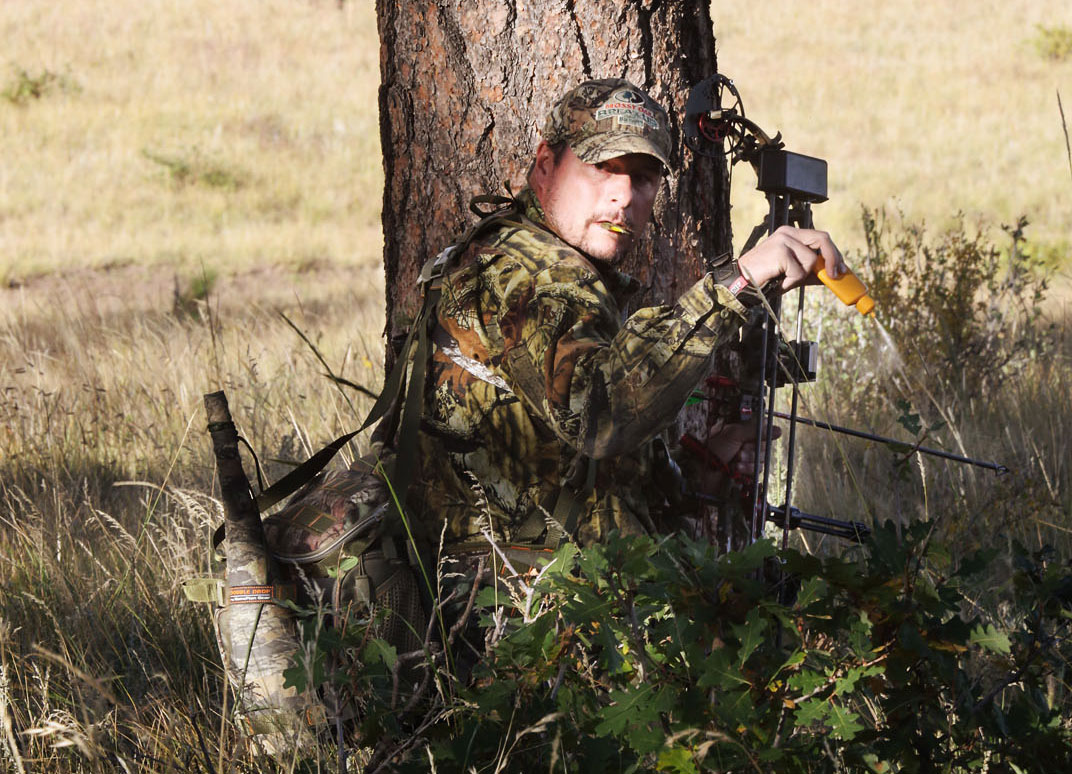Brad Mormann | Originally published in GameKeepers: Farming for Wildlife Magazine. To subscribe, click here.

It’s the peak of the chase-phase and you somehow made enough phone calls to free up your evening schedule so you could spend a few hours in your treestand. You develop a stand entrance game plan on your way to your property and execute it perfectly. As the sun sinks to touch the horizon you can sense deer moving toward you and then, out of nowhere the woods erupts with an unseen deer snorting and stomping. You cringe and possibly mumble under your breath that your position has been compromised. Luckily, it’s not the end of your hunt, but your confidence is spent and you question if you’ll see anything in the remaining waning shooting light.
A deer’s sense of smell is a powerful instrument in their defensive toolbox. It is one of the reasons why deer are so challenging and fun to hunt. Learning to work your offense to beat this incredible defense can be done by understanding and utilizing wind and thermal currents. Here are five items to consider as you prepare to hunt this fall:
1. Wind and Thermal

season. Determine the optimum wind direction for each
stand site before you plan to hunt.
Wind direction is the primary aspect that affects the success of our hunts each fall. Wind direction can be affected by many factors such as terrain, vegetation types, vegetation density, temperatures and the jet stream and so on. Air masses moving through an area can cause the wind direction to change 180 degrees in a relatively short time. The prevailing wind direction for a region is the single most important wind direction to focus on when setting up a property for effective hunting, including the placement of habitat work such as clear cuts food plots and tree stands. For most whitetail hunters, the prevailing wind is a west wind of some sort, from south southwest to north northwest.
Thermals are the movement of air due to temperature – warm air rises and cool air sinks. Thermals associated with local terrain are somewhat predictable in that they are pronounced in the evening and morning when the wind is not blowing, especially in hilly or mountainous terrain.
Places where thermals have the greatest impact on a hunt are when trying to hunt the bottom of valleys. Valley bottoms are great places to find deer crossings as deer generally funnel into worn muddy trails as they cross creeks. The challenge is finding a spot or time of day when the air currents aren’t swirling in these bottom areas.
Hunting ridge tops is generally the easiest way to avoid swirling air currents, but sometimes that is not possible or practical. This was certainly the case in the Ozarks of southern Missouri, where “I have hung my stands,” so to speak, for over a decade. The rugged terrain and deep valleys meant that if you wanted to hunt across a property at least some stands needed to be in or near the bottom of the valleys. This is where learning local thermal air movement is critical.
As I mentioned, the issue wasn’t determining if the thermals were happening, it was when they were going to switch. This is because each day as the air temperature began to warm, thermals would rise up the valleys. Late in the day when the shadows lengthened the temperature would begin dropping and they would switch and go down the valleys. In the early morning, they would always be flowing down the valley and then sometime before 11 A.M. they would start going up. This generally meant a quality one to four-hour hunt could be had before the wind switched and ruined the stand site each morning. Evenings worked the opposite direction but the wind switch often occurred closer to sunset.
Not all trees are great stand sites. Narrow down your potential stand sites by learning deer patterns and monitoring the wind and thermal.
2. Multiple Stand Sites for Multiple Wind Directions
Back when I was cutting my teeth bowhunting, I had just one treestand located in the old crow’s nest. The crow’s nest was a tried and true stand that my family had been successfully hunting from for two generations before I started hunting. The homemade stand was in disarray by the time I came along and on the second year I hunted from it, a strong storm split the tree in two. The stand had trails passing by in several directions and I planned to bow hunt it the entire season.

incorrect and because sometimes we guess wrong, a
thorough system of scent elimination should be used. It’s in
all probability impossible to be totally “scent-free” to deer;
however, the Scent Killer system will reduce foreign odors
to nominal trace levels that even mature bucks will tolerate
in close proximity.
Now don’t get me wrong, I definitely saw a lot of deer from that stand, but the quality of deer was not what the family folklore had indicated. Nobody ever let on, but years later I learned that I had simply been wearing out the stand site with repeated hunts during all weather conditions and wind directions. So whether it is from scent or physical disturbance, the stand site was well burned out. This is a situation where simply “putting in my time” had a diminishing effect on my chance of success.
This is when I started investing money in more treestands. Now I have treestands positioned for all wind directions, approach scenarios and thermal patterns scattered throughout my hunting properties. No longer do I have to sit at home fuming that I have nowhere to hunt or worry I may spook deer by slipping into a stand with the wrong wind. Having stand choices is especially important when working around an inflexible schedule. This has occasionally been the case throughout the years as work or family obligations caused me to slip out when I had time instead of when the time was right. Being prepared with ample stand sites ensures at least one or two stand sites have the right wind for a quality hunt.
Now, what if the cost of having several stands is out of your reach or you hunt on a lot of public land and you don’t feel comfortable leaving stands in the tree? This is where a climbing stand can be effective. However, because it’s a good idea to have shooting lanes when entering a stand, selecting several good climbing stand sites and trimming shooting lanes before the season is the most effective.
An important aspect in hanging stands for varying wind directions is to have a good handle on exactly what wind directions work well for the site. Placing treestands often means traveling down winding logging roads and busting brush with the stand, steps, and saw in tow. This process, even for the seasoned hunter, can cause some disorientation and confusion when a certain wind just doesn’t work right after slipping into the stand undetected during a hunt. There are smartphone apps that can pinpoint your location on a map while you are at the stand site, but cellular service may not always be available. This is where I continue to utilize my old-school compass. Taking a moment to determine the optimum wind directions for a stand as I hang it saves me time and disturbance during my valuable hunting season.
3. Time in the Field
Time spent on a property and in each stand location is the only way to truly learn how air flows through the property whether by thermals or wind. This is also true for how exactly deer move around in relation to air currents, terrain, and vegetation. There is no doubt studying terrain and aerial maps can unveil a lot of information about a property but especially the first season or two, time in the field is critical to successful hunting. Let’s face it, sometimes that worn trail that looked like a deer highway turns out to have little or no daylight movement, but still having the appearance of a true hotspot. It can happen the opposite also, as it did for me hunting a new property last fall. It was early November and I was hunting an area with quite a bit of topography. My stand was toward the top of a ridge overlooking a well-worn trail. From behind me and directly downwind five bucks were chasing a doe on the next ridge. I blew a series of tending grunt calls and the largest of the bucks peeled off and came my direction. For one hundred and fifty yards he walked through a seriously deep ravine from my downwind direction. Although I work diligently to keep my scent at a minimum, to a sense of smell as powerful as a whitetails’ it’s never completely eliminated. The only possible explanation was that it was a sunny morning and the thermals had switched in time to carry my scent up and out of the ravine instead of down into it, providing the buck a path free of my scent.
As you can imagine, I learned things about that stand site that morning. With a little luck I had a good blood trail to follow with my two young children whom I grabbed from school. They were giddy with excitement and nearly as loud as a baying bloodhound, but fun was had by all as we approached the grand downed buck.
4. The Optimum Wind Direction

The optimum wind direction is one that carries your scent somewhere deer can’t pick it up. When available, the best downwind direction is off a steep drop off or over lakes or large ponds. All of these provide areas where there is little chance that a deer will pick up your scent. Fingers of large lakes are particularly effective locations because they pinch deer into narrow areas as the deer travel along the water line. Not only are deer less likely to cross behind you if the lake is at your back, before it freezes the water temperature is often warmer than the air temperature which ensures your scent flows out over the lake and not to the deer’s nose. In more flat terrain with fields or food plots the goal is to have the wind blowing away from both the trail and the food source. It never fails during an evening hunt that if the wind is blowing toward the food source, at least one button buck or yearling doe will enter the area well before a mature buck. They often spend hours milling around increasing the chances of them picking up your scent and blowing your cover.
5. Weather Data
Technology is always changing but currently one of my favorite weather data websites is the National Weather Service’s Hourly Weather Graph. This graph provides six days’ worth of hour-by-hour wind direction and speed, in addition to precipitation timing and temperature. Data like this makes each hunt’s stand selection much easier and has amazing accuracy. Especially when my stands are near ridge tops and a compass was used when hanging the stand, rarely am I caught off guard by the wind.
A deer’s sense of smell is an incredible defense to overcome when hunting, but luckily there are effective strategies that can improve your offense. By understanding how wind and thermals flow through your property you can use the deer herd’s primary defense to your advantage. This fall take an extra look at how your hunting stands are positioned in relation to air movements and how deer move around the property. You may just find one more opportunity to get a leg up on your quarry and keep your scent out of reach of the herd’s nose.































